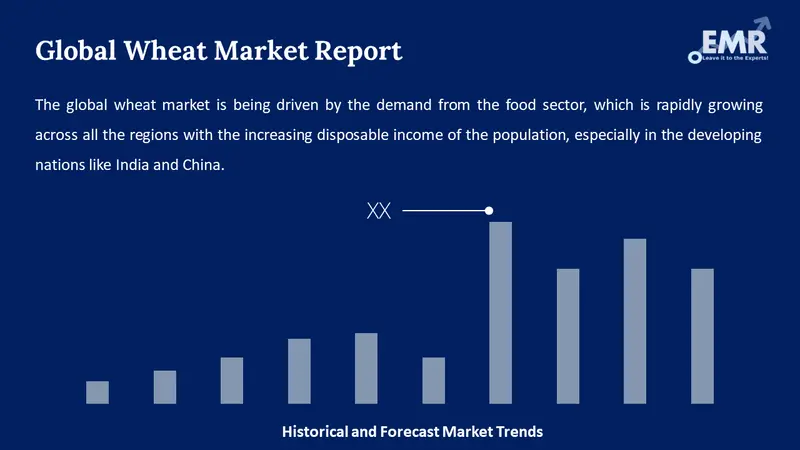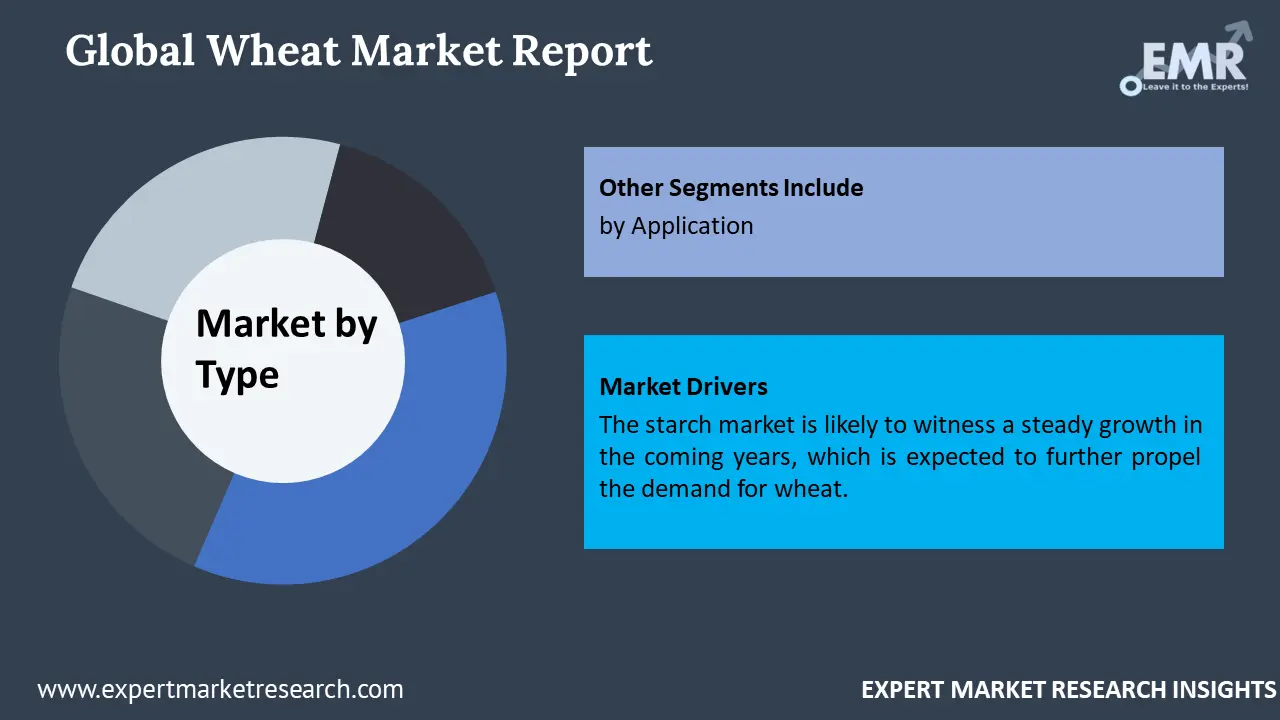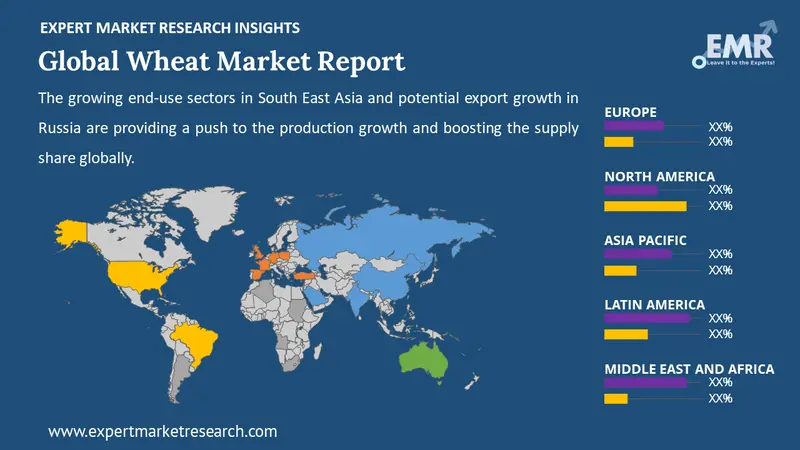
Consumer Insights
Uncover trends and behaviors shaping consumer choices today
Procurement Insights
Optimize your sourcing strategy with key market data
Industry Stats
Stay ahead with the latest trends and market analysis.
Trending Now



The global wheat market reached a consumption value of around USD 161.32 billion in 2024. The consumption is expected to grow at a CAGR of 5.3% in the forecast period of 2025-2034, to reach a value of USD 256.8 billion.
Base Year
Historical Year
Forecast Year






| Global Wheat Market Report Summary | Description | Value |
| Base Year | USD Billion | 2023 |
| Historical Period | USD Billion | 2018-2024 |
| Forecast Period | USD Billion | 2025-2034 |
| Market Size 2024 | USD Billion | 161.32 |
| Market Size 2034 | USD Billion | 256.8 |
| CAGR 2018-2024 | Percentage | XX% |
| CAGR 2025-2034 | Percentage | 5.3% |
| CAGR 2025-2034 - Market by Region | Asia Pacific | 5.8% |
| CAGR 2025-2034 - Market by Country | India | 6.6% |
| CAGR 2025-2034 - Market by Country | Mexico | 5.8% |
| CAGR 2025-2034 - Market by Type | Flour | 5.6% |
| CAGR 2025-2034 - Market by Application | Biofuel | 5.9% |
| Market Share by Country 2023 | USA | 14.2% |

Read more about this report - REQUEST FREE SAMPLE COPY IN PDF
The global wheat market value is increasing due to the growing food sector and increasing population, especially in developing nations like India and China. With globalisation, the prevalence of processed food has seen faster growth and, thus, is driving the demand for wheat. The crop is a staple food product in many regions, especially in India, among other Asian countries.
Further, the expanding starch market favours the growth of the wheat industry. The demand for wheat starch has been witnessing a healthy growth for many years and the growth is likely to be more in the coming years, owing to the increasing popularity of processed food.
Wheat starch is also in demand among health-conscious people due to the product being gluten-free and low in calorie content. Additionally, wheat also provides protein, vitamin B, dietary fibre, and phytochemicals. The increasing demand for personal care products including dry shampoo, cleansers, and lotions, is further pushing the wheat starch market.
Global wheat production trends from 2018 to 2024 indicate significant fluctuations according to the International Grains Council. In 2018, production was 761.7 million tons, dropping by 3.9% in 2019 to 732.1 million tons. This trend reversed in 2020 with a 3.9% increase to 760.8 million tons. Moderate increases followed, peaking at 803.6 million tons in 2023 before a slight 1.6% decrease to 790.4 million tons in 2024. These variations can be attributed to changing weather patterns and global economic conditions affecting farming outputs.
The increasing import and export of wheat are also supporting the global wheat market development. Russia, along with the European Union, the United States, Canada, and Australia exports large volumes of the crop to other regions.
The increasing global population, dietary preferences shifting towards grains, and expanding applications in food and industrial sectors drive the wheat demand growth.
China's wheat production remained relatively stable, starting at 134.3 million tons in 2018 and seeing minor fluctuations. The highest production was in 2022 at 137.9 million tons, slightly decreasing to 136.6 million tons in 2024. Consistency in production is critical for China to ensure food security for its vast population. China's growing yield reflects the country’s significant investments in agricultural modernization and technology.
The USA saw a notable increase of 8.2% in 2019 to 51.3 million tons but experienced a downward trend to 44.8 million tons in 2022. Production rose again by 9.8% in 2024, reaching 49.3 million tons. This volatility underscores the impact of economic and climatic factors on wheat production.
In 2022, wheat yields across various regions demonstrated notable disparities, measured in tonnes per hectare. Ireland achieved the highest yield at 10.43 t/ha, followed by the Netherlands at 9.39 t/ha, and the United Kingdom at 8.59 t/ha, according to “Our World In Data”. These high yields can be attributed to the implementation of advanced agricultural technologies, favorable climatic conditions, and efficient farming practices.
India’s production showed steady growth, starting at 98.5 million tons in 2018 and reaching 108 million tons in 2024. Consistent year-over-year increases reflect improvements in agricultural practices and policies. The global wheat industry trends highlight the interconnected nature of the market, crucial for global food security and trade stability.
Also, the government initiatives to boost the production of wheat in order to make the country self-sufficient and improve food security are some of the crucial market trends.
The National Food Security Mission (NFSM) in India aims to increase the production of wheat and other food grains through productivity enhancement and soil fertility restoration. The efforts taken to provide novel and improved crop production technologies and the distribution of high-yielding varieties/hybrid seeds are expected to drive the demand for wheat in India.

Read more about this report - REQUEST FREE SAMPLE COPY IN PDF
| CAGR 2025-2034 - Market by | Type |
| Flour | 5.6% |
| Whole/Raw | 5.1% |
| Others | XX% |
The market for wheat, based on type, is divided into:
| CAGR 2025-2034 - Market by | Application |
| Biofuel | 5.9% |
| Feed | 5.5% |
| Food | XX% |
| Others | XX% |
Based on application, the market is segmented into:
| CAGR 2025-2034 - Market by | Region |
| Asia Pacific | 5.8% |
| Middle East | 5.5% |
| North America | XX% |
| Europe | XX% |
| Latin America | XX% |
| CAGR 2025-2034 - Market by | Country |
| India | 6.6% |
| Mexico | 5.8% |
| Australia | 5.5% |
| France | 5.4% |
| USA | 5.0% |
| Canada | XX% |
| UK | 4.9% |
| Germany | XX% |
| Italy | XX% |
| China | XX% |
| Japan | XX% |
| Saudi Arabia | XX% |
| Brazil | XX% |
The EMR report also covers the regional markets of wheat like North America, Europe, the Asia Pacific, Latin America, and the Middle East and Africa.
| 2023 Market Share by | Country |
| USA | 14.2% |
| Canada | XX% |
| UK | XX% |
| Germany | XX% |
Owing to wheat flour being a staple ingredient in many diets, the demand is expected to surge along with the rising demand for basic food items
According to the wheat market analysis, flour occupies a substantial share of the market. As the global population increases, the demand for basic food items like wheat flour typically rises. This is because wheat flour is a staple ingredient in many diets around the world. Changes in dietary trends can significantly impact wheat flour demand. For instance, a rise in the popularity of baking or an increased preference for wheat-based products can drive up demand.
Increasing Demand for Biofuel to Support Wheat Demand in the Coming Years
The use of wheat as a biofuel primarily revolves around the production of bioethanol, a renewable energy source. Wheat-based ethanol is renewable and can help reduce dependence on fossil fuels. Burning wheat ethanol produces fewer greenhouse gases compared to conventional fuels, thus contributing to reduced environmental impact. In regions with surplus wheat production, converting wheat to bioethanol can provide an alternative market for farmers.
The report offers a detailed analysis of the following key players, covering their competitive landscape and latest developments like mergers and acquisitions:
Other key players include Nisshin Flour Milling INC., Siemer Milling Company, Miller Milling Company, Grain Craft, General Mills, ITC Limited, Farm Fresh Wheat, Sunnyland Mills, and Bay State Milling Company, among others.

Read more about this report - REQUEST FREE SAMPLE COPY IN PDF
The major wheat-producing regions include the European Union, China, India, Russia, and the United States, with the European Union accounting for a fifth of the total global wheat output.
Russia is the leading exporter in the global wheat market, accounting for nearly 18.5% of the total global exports of the crop. The output level especially in Russia and the European Union is rising owing to consumption growth and low harvest in the United States. The growing end-use sectors in Southeast Asia and potential export growth in Russia are providing a push to production growth and boosting the supply share globally.
The major wheat consuming regions include the European Union, accounting for nearly 45% of the global consumption. Other major consumers are China, India, Russia, and the United States. The European Union also imports wheat to meet the domestic demand. Egypt, Indonesia, Brazil, and Algeria are among the major wheat importing regions.
The global wheat market demand is supported by the expanding wheat starch market, which reached a volume of around 5 million metric tons in 2020. The starch market is likely to witness steady growth in the coming years, which is expected to further propel the demand for wheat. The major wheat starch-producing regions are France, the United States, the Netherlands, the United Kingdom, Australia, Belgium, Canada, China, and Japan.
| Report Features | Details |
| Base Year | 2023 |
| Historical Period | 2018-2024 |
| Forecast Period | 2025-2034 |
| Scope of the Report |
Historical and Forecast Trends, Industry Drivers and Constraints, Historical and Forecast Market Analysis by Segment:
|
| Breakup by Type |
|
| Breakup by Application |
|
| Breakup by Region |
|
| Market Dynamics |
|
| Trade Data Analysis |
|
| Competitive Landscape |
|
| Competitive Landscape |
|
| Report Price and Purchase Option | Explore our purchase options that are best suited to your resources and industry needs. |
| Delivery Format | Delivered as an attached PDF and Excel through email, with an option of receiving an editable PPT, according to the purchase option. |
*While we strive to always give you current and accurate information, the numbers depicted on the website are indicative and may differ from the actual numbers in the main report. At Expert Market Research, we aim to bring you the latest insights and trends in the market. Using our analyses and forecasts, stakeholders can understand the market dynamics, navigate challenges, and capitalize on opportunities to make data-driven strategic decisions.*
Get in touch with us for a customized solution tailored to your unique requirements and save upto 35%!
In 2024, the wheat market reached a value of USD 161.32 billion.
The market for wheat is expected to grow at a CAGR of 5.3% between 2025 and 2034.
The market is estimated to witness a healthy growth in the forecast period of 2025-2034 to reach USD 256.8 billion by 2034.
The major drivers of the market include the rising disposable incomes, increasing population, and rising demand for low-calorie sweeteners and gluten-free food.
Key trends aiding the market expansion include the increasing focus on sustainable farming methods and the development and adoption of genetically modified wheat varieties.
North America, Europe, the Asia Pacific, Latin America, and the Middle East and Africa are the significant markets for wheat.
The major types of the product include whole/raw and flour, among others.
The major applications include feed, food, and biofuel, among others.
Key players in the market are Nisshin Flour Milling INC., Siemer Milling Company, Miller Milling Company, Grain Craft, General Mills, ITC Limited, Ardent Mills, Farm Fresh Wheat, Sunnyland Mills, Bay State Milling Company, and Others.
The wheat market demand is being driven by the demand from the food sector, especially in developing nations like India and China.
Unpredictable weather patterns and extreme conditions, increased incidence of pests and diseases, and geopolitical tensions are the key challenges in the market.
Datasheet
One User
USD 2,499
USD 2,249
tax inclusive*
Single User License
One User
USD 3,999
USD 3,599
tax inclusive*
Five User License
Five User
USD 4,999
USD 4,249
tax inclusive*
Corporate License
Unlimited Users
USD 5,999
USD 5,099
tax inclusive*
*Please note that the prices mentioned below are starting prices for each bundle type. Kindly contact our team for further details.*
Flash Bundle
Small Business Bundle
Growth Bundle
Enterprise Bundle
*Please note that the prices mentioned below are starting prices for each bundle type. Kindly contact our team for further details.*
Flash Bundle
Number of Reports: 3
20%
tax inclusive*
Small Business Bundle
Number of Reports: 5
25%
tax inclusive*
Growth Bundle
Number of Reports: 8
30%
tax inclusive*
Enterprise Bundle
Number of Reports: 10
35%
tax inclusive*
How To Order
Our step-by-step guide will help you select, purchase, and access your reports swiftly, ensuring you get the information that drives your decisions, right when you need it.

Select License Type
Choose the right license for your needs and access rights.

Click on ‘Buy Now’
Add the report to your cart with one click and proceed to register.

Select Mode of Payment
Choose a payment option for a secure checkout. You will be redirected accordingly.
Gain insights to stay ahead and seize opportunities.

Get insights & trends for a competitive edge.

Track prices with detailed trend reports.

Analyse trade data for supply chain insights.

Leverage cost reports for smart savings

Enhance supply chain with partnerships.

Connect For More Information
Our expert team of analysts will offer full support and resolve any queries regarding the report, before and after the purchase.
Our expert team of analysts will offer full support and resolve any queries regarding the report, before and after the purchase.
We employ meticulous research methods, blending advanced analytics and expert insights to deliver accurate, actionable industry intelligence, staying ahead of competitors.
Our skilled analysts offer unparalleled competitive advantage with detailed insights on current and emerging markets, ensuring your strategic edge.
We offer an in-depth yet simplified presentation of industry insights and analysis to meet your specific requirements effectively.



Australia
63 Fiona Drive, Tamworth, NSW
+61-448-061-727
India
C130 Sector 2 Noida, Uttar Pradesh 201301
+91-723-689-1189
Philippines
40th Floor, PBCom Tower, 6795 Ayala Avenue Cor V.A Rufino St. Makati City,1226.
+63-287-899-028, +63-967-048-3306
United Kingdom
6 Gardner Place, Becketts Close, Feltham TW14 0BX, Greater London
+44-753-713-2163
United States
30 North Gould Street, Sheridan, WY 82801
+1-415-325-5166
Vietnam
193/26/4 St.no.6, Ward Binh Hung Hoa, Binh Tan District, Ho Chi Minh City
+84-865-399-124
United States (Head Office)
30 North Gould Street, Sheridan, WY 82801
+1-415-325-5166
Australia
63 Fiona Drive, Tamworth, NSW
+61-448-061-727
India
C130 Sector 2 Noida, Uttar Pradesh 201301
+91-723-689-1189
Philippines
40th Floor, PBCom Tower, 6795 Ayala Avenue Cor V.A Rufino St. Makati City, 1226.
+63-287-899-028, +63-967-048-3306
United Kingdom
6 Gardner Place, Becketts Close, Feltham TW14 0BX, Greater London
+44-753-713-2163
Vietnam
193/26/4 St.no.6, Ward Binh Hung Hoa, Binh Tan District, Ho Chi Minh City
+84-865-399-124
Share